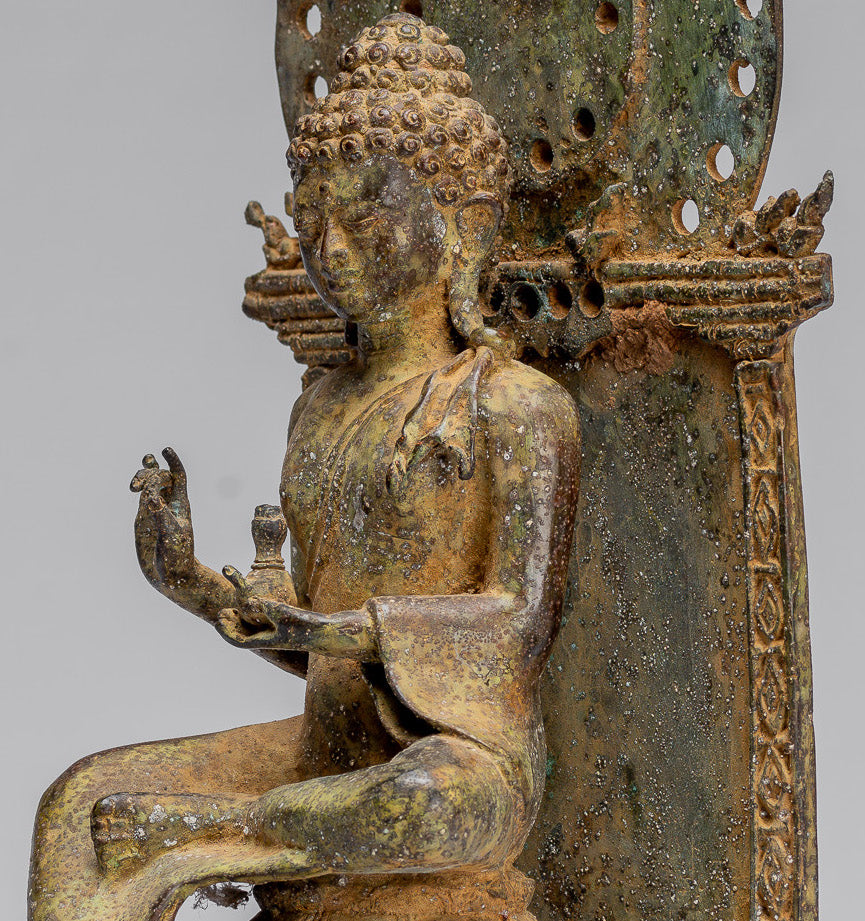-
Antique Indonesian Style Seated Bronze Javanese Teaching Buddha - 27cm/11"
Measures (Height) 27cm/11"
An Indonesian (Java) seated Teaching Buddha in 13th century Majapahit style.
The Buddha is seated, in the vajra position with his right leg is panhandle resting upon a lotus flower. The lotus flower represents purity, compassion and the giving of great joy to all.
The Buddha is seated on a double lotus flower base with his right foot resting on a separate lotus flower. The lotus bud pedestal is set upon a simple square pedestal.
The lotus flower represents the attaining of enlightenment and the ultimate fulfilment that follows. This symbol is heavily used in Eastern religions, which is why it can appear as both a held item or a seat. Some say that as the lotus flower grows in dirty water but becomes something beautiful, it demonstrates how we must forget our attachments to the material world around us and focus on our inner spirituality in order to seek happiness.
His robe is draped over his left shoulder, and a portion of the garment that covers the left wrist falls behind the figure. The lower hem of the robe comes all the way down so that the under-cloth or skirt is completely covered.
An aureole or halo sits behind the head of the Buddha. This circle of light symbolise his divinity.
He holds his hands in front of his chest in the dharmachakra mudra. In sanskrit dharmachakra means the 'Wheel of Dharma'.
This mudra symbolises one of the most important moments in the life of Buddha, the occasion when he preached to his companions the first sermon after his Enlightenment in the Deer Park at Sarnath. It therefore denotes the setting into motion of the Wheel of the teaching of the Dharma. In this mudra the thumb and index finger touch at their tips to form a circle. This circle represents the Wheel of Dharma, or in metaphysical terms, the union of method and wisdom. This symbolises generosity. The detail and patina of the piece are delightful.
In his hands he holds a kalasha. The kalasha is considered a symbol of abundance. The Kalasha is believed to contain amrita, the elixir of life, and thus is viewed as a symbol of abundance, wisdom, and immortality.
Provenance: Ex- private Singapore collection. All items are guaranteed to be as described. A Certificate of Authenticity will accompany all purchases upon request.
SATISFACTION GUARANTEE - We have been offering SE Asian Art for many years and are proud of the reputation we have developed for fair and honest listings. However, if for any reason, whatsoever, you are unhappy with your purchase please just let us know and we will provide a full refund. We want you to be 100% happy with your purchase.
-
The majority of orders will be shipped with DHL. This is a secure, express and fully tracked service.
Items less than 2Kg we typically ship using Royal Mail.
Once we receive your order we try to ship all orders the same or next working day.
Large and/or fragile pieces requiring palletising, specialist crating and/or extra packaging may take a little longer. Palletised shipments will be delivered curbside.
All orders over 35 GBP will be shipped free of charge.

-
We genuinely hope that all purchases delight.
However, if they do not, regardless of reason, we will refund all orders upon receipt of the unwanted item. Just notify us within 14 days of receiving your order that you wish to make a return and send the piece back to us with 30 days of delivery.
The Golden Age of Majapahit Art represents a period of extraordinary creativity and cultural synthesis, producing works of lasting beauty and profound spiritual significance.
From the majestic temples of Trowulan to the intricate terracotta sculptures, Majapahit art offers a glimpse into the rich cultural tapestry of one of Southeast Asia’s greatest empires.
















































